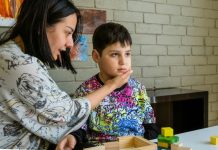
In a new study from the University of Virginia, researchers found how autism-spectrum disorder (ASD) manifests in the brains of girls.
The researchers discovered that there is a big difference in the genes and ‘genetic burden’ that underpin the condition in girls and boys.
They also identified specific ways the brains of girls with ASD respond differently to social cues such as facial expressions and gestures than do those of girls without ASD.
The scientists warn that conclusions drawn from studies conducted primarily in boys should not be assumed to hold true for girls.
In the study, the team combined cutting-edge brain imaging with genetic research to better understand ASD’s effects in girls. Those effects have remained poorly explored because the condition is four times more common in boys.
The team used functional magnetic-resonance imaging (fMRI) to examine brain activity during social interactions. They found that autistic girls used different sections of their brains than girls who did not have ASD.
And, most surprisingly, the difference between girls with and without autism was not the same as the difference in the brain seen when comparing boys with and without autism, revealing different brain mechanisms at play in autism depending on a person’s gender.
Likewise, the underlying genetic contributors were quite different, the researchers found.
Girls had much larger numbers of rare variants of genes active during the early development of a brain region known as the striatum.
This suggests that the effects on the striatum may contribute to ASD risk in girls. (Scientists believe a section of the striatum called the putamen is involved in interpreting both social interaction and language.)
The team says the convergence of the brain imaging and genetic data provides them with an important new insight into the causes of autism in girls.
They hope to leverage the findings to generate new treatment strategies tailored to autistic girls.
The study is published in Brain. One author of the study is Kevin Pelphrey, Ph.D.
Copyright © 2021 Knowridge Science Report. All rights reserved.



